Attracting Birds to Your Trees and Landscaping
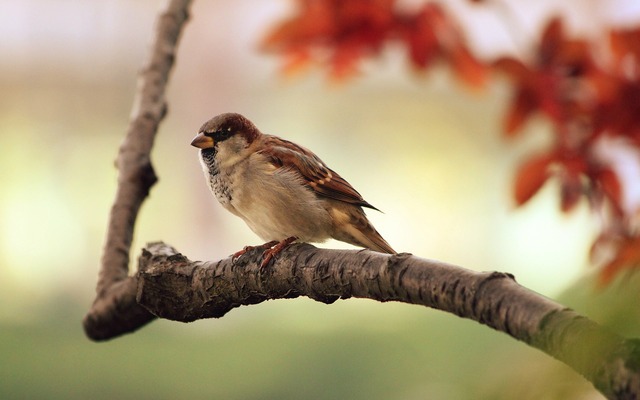
Bird-Friendly Backyard Practices
Picture this: you step into your backyard, and it's alive with the delightful sounds and colors of birds. It's not just a beautiful sight; it's an eco-friendly choice that comes with a host of benefits.
This guide is your key to creating a bird-friendly space in your own yard. But why should you care about inviting birds into your landscaping and trees? The answer is simple: birds provide invaluable help with weed control, pest management, and pollination. They can even enhance your property's value.
In addition to the practical benefits, welcoming birds into your outdoor space can be relaxing, educational, and eco-conscious. It's a simple way to support local wildlife and learn more about the environment around you.
So, let's dive into the world of bird-friendly landscaping. We'll show you how to make your garden a welcoming haven for our feathered friends.
The Benefits of a Bird-Friendly Landscape
If you're wondering why you should attract birds to your landscaping and trees, there are numerous benefits to consider:
Weed Control
Certain bird species like finches and sparrows play a crucial role in weed control by consuming weed seeds, reducing the need for manual weeding in your garden. Additionally, if you have plants with seeds, birds have a fantastic natural food source.
Pest Control
Many birds are natural predators of insects and arachnids, including spiders, aphids, mosquitoes, and other common pests. Attracting birds to your landscaping can help control these pests, reducing the need for chemical pesticides.
Flower Pollination
Birds like hummingbirds and orioles sip nectar, making them efficient pollinators for your garden flowers. This can lead to more blooms and a vibrant garden, which will in turn attract more birds.
Aesthetics
The presence of colorful, chirping birds can enhance the natural beauty of your landscaping, making your property more welcoming and potentially increasing its value.
Wildlife Conservation
Creating a bird-friendly backyard provides a haven for both local and migrating bird species, contributing to wildlife conservation.
Stress Relief
Spending time outdoors watching birds and tending to your bird-friendly landscape can be a relaxing and stress-relieving activity. It also provides an opportunity to soak in some vitamin D.
Education
Birdwatching can be an educational experience. Observing your local wildlife and bird species will give you insight into your local ecosystems and the different species around you.
Choose the Right Type of Trees
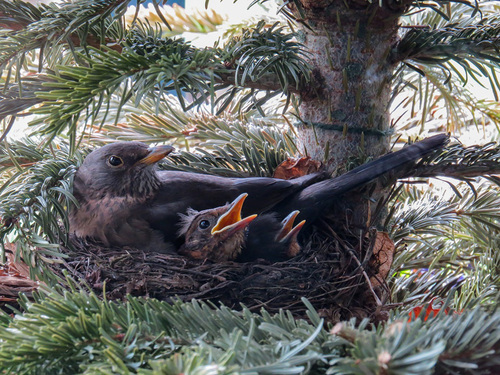
A Mother Bird in Her Nest with Two Young Chicks
Trees provide all the basic needs of a bird, including food, shelter, and water. Birds derive food from the nuts, pests, sap, and fruit, and they drink water that collects on the leaves. Tree branches are perfect for housing birds since they can build their nests safely in them. Most trees will be of some benefit to these creatures, but certain ones may work out better for different birds' needs.
To attract and house birds effectively, consider the following tips:
Climate-Appropriate Trees
When planting new trees, select species that are suitable for your climate and region to ensure they thrive in your area.
Tree Variety
Plant a variety of trees, including fruit trees, coniferous trees, and deciduous trees. This diversity attracts a wide range of bird species and provides them with various resources.
Different Shapes and Sizes
Vary the shapes, sizes, and thickness of your trees to accommodate different bird species and their preferences for housing.
Native Trees
Native trees are especially attractive to local bird species. These trees have adapted to the local environment and provide natural food sources and shelter.
Create Bird-Friendly Zones
Designate specific areas in your landscaping as bird-friendly zones. These areas can include bird-friendly plants, feeders, and birdhouses.
Provide Them With Food
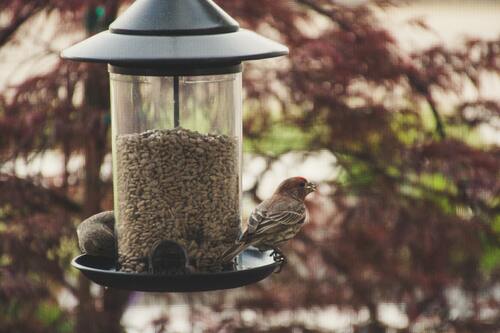
Two Birds Enjoy a Tube Feeder Full of Sunflower Seeds
To entice birds to your landscaping, you may want to offer them some additional incentives. Having a few bird feeders is a great way to attract some local species.
Consider the following:
Bird Feeders
Use bird feeders to provide birds with food. In order to do this properly, be sure to research the types of birds you will most likely encounter in your local area. Different species prefer different feeders and types of food, so it will help you to know who you are going to be feeding.
- House Feeders: These feeders have an aesthetically pleasing design and protect birdseed from larger animals.
- Tray Feeders: Tray feeders allow birds to feed freely but are vulnerable to squirrels and wet weather.
- Suet Feeders: Suet feeders offer suet cakes, a specialized food that attracts birds like nuthatches, woodpeckers, and chickadees. This design has a wire cage around it, so it won’t be as accessible to other animals.
- Window Feeders: For convenient indoor birdwatching, attach window feeders with suction cups to your window. These feeders tend to attract birds like finches, chickadees, and certain kinds of sparrows.
- Tube Feeders: Tube feeders are suitable for various bird species and dispense food at the bottom. Some tube feeders are specifically designed for hummingbirds and dispense sugar water.
Bird Baths
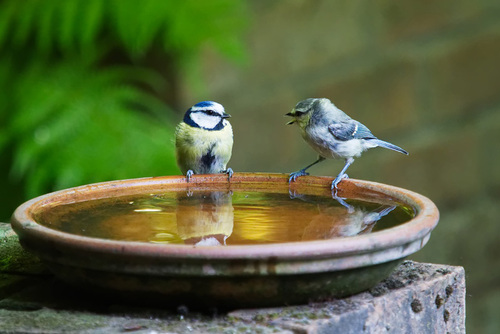
Birds Enjoying a Refreshing Stop at a Bird Bath
In addition to feeders, provide birds with fresh water for drinking and bathing. Bird baths can be an attractive addition to your bird-friendly landscape and are essential for the overall well-being of the birds.
Plant Bird-Friendly Shrubs and Flowers
Include bird-friendly shrubs and flowers in your landscaping to provide birds with natural sources of nectar, seeds, and insects. Native plants are especially effective in attracting local bird species.
Seasonal Variety
Offer a variety of foods throughout the seasons. Birds have different dietary preferences during different times of the year. For example, during winter, high-energy foods like suet are vital for their survival.
Create Nesting Spots
In addition to the right trees, create comfortable nesting spots for birds:
Birdhouses
Choose birdhouses that match the preferences of the bird species in your area. Different shapes, orientations, and hole sizes attract various species. Consider the following types of birdhouses:
- Bluebird Houses
Bluebirds are cavity-nesting birds, and bluebird houses are designed specifically for them. Place these houses at appropriate heights and clear them out between broods.
- Wren Houses
Wrens are known for building nests in cavities, and wren houses are ideal for attracting them. These houses should be hung in a sheltered location.
- Purple Martin Houses
Purple martins are colonial nesters and often use multi-compartment houses. These houses should be placed on a pole in an open area.
- Nesting Platforms
Some birds, like robins and mourning doves, prefer nesting platforms rather than enclosed houses. These platforms can be simple wooden structures placed in suitable locations.
Natural Nesting Areas
Allow your yard to become a bit more natural by building brush piles or letting the grass grow higher in specific areas. This creates habitats similar to those in the wild, attracting birds for nesting.
Provide Shelter
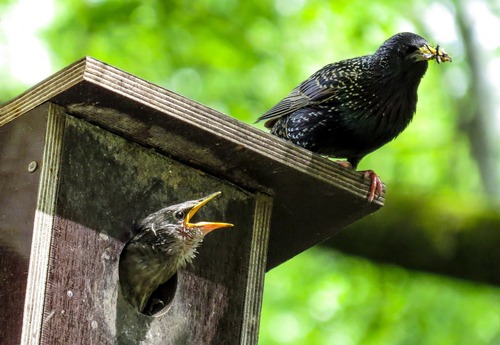
A Mother Bird Using a Wooden Birdhouse to Shelter Her Young
Birds need shelter not only for nesting but also for protection from the elements and predators. Consider the following when providing shelter:
Roosting Boxes
Roosting boxes are designed for birds to seek shelter during cold winter nights. They provide a communal space for birds to conserve body heat.
Native Plants and Trees
Plant native trees and shrubs that offer natural shelter to birds. These plants also provide nesting sites and food sources.
Evergreen Trees
Evergreen trees, such as pine and spruce, provide year-round shelter due to their dense foliage. Birds can seek refuge from harsh weather in the branches of these trees.
Nesting Materials
Provide nesting materials in your yard, such as twigs, leaves, and grass, to assist birds in building their nests. This simple addition can be especially beneficial during nesting season.
Bird-Friendly Landscaping Tips
Here are some additional tips to ensure your landscaping is truly bird-friendly:
Reduce Pesticide Use
Minimize or eliminate the use of chemical pesticides and herbicides in your garden. These chemicals can harm birds directly or by reducing their insect prey.
Minimize Light Pollution
Excessive outdoor lighting can disorient nocturnal birds. Use bird-friendly lighting options, such as motion-activated lights, and avoid leaving lights on overnight.
Keep Cats Indoors
Domestic cats are a significant threat to birds. Keeping your cats indoors or supervising their outdoor activities can help protect local bird populations.
Create a Diverse Habitat
Incorporate a variety of plants, shrubs, and trees to create a diverse habitat that appeals to different bird species. This diversity ensures that you attract a wide range of birds.
Regular Maintenance
Regularly maintain your bird-friendly features, such as feeders, birdhouses, and water sources. Clean feeders and bird baths to prevent disease transmission.
Respect Local Regulations
Check local regulations and permits related to birdhouses and feeders. Some areas may have specific guidelines to follow.
Conclusion
As we conclude this guide to attracting birds to your landscape, we hope you're inspired to embark on this avian adventure. By embracing the simple yet effective practices outlined here, you're not only creating a more inviting garden but also playing a role in supporting local ecosystems.
The benefits of a bird-friendly landscape are numerous—from natural weed control to the joy of watching these winged wonders in action. You can elevate the beauty of your outdoor space, foster wildlife conservation, and find solace in the calming effect of nature.
By implementing these tips, you are not just creating a beautiful garden but also contributing to a livelier, more vibrant ecosystem. Your efforts can positively impact local bird populations, making your garden a thriving habitat for birds.
If you have any further questions or need assistance in creating your bird-friendly landscape, don't hesitate to reach out to us!
Originally posted on October 5, 2018





